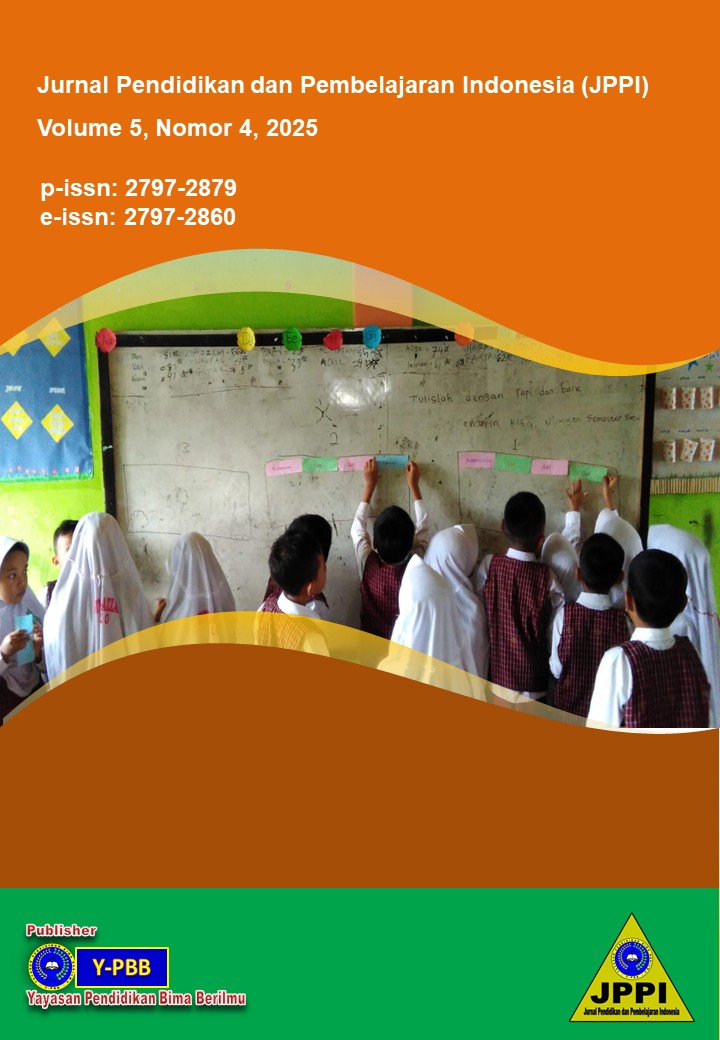Evaluation of Readiness among Prospective Mechanical Engineering Vocational Teachers to Apply Generative AI in Education Using Technology Acceptance Model (TAM)
DOI:
https://doi.org/10.53299/jppi.v5i4.2530Keywords:
GenAI, Vocational Teacher Readiness, Mechanical Engineering EducationAbstract
This study evaluates the readiness of prospective vocational school teachers in integrating Generative Artificial Intelligence (GenAI) into learning using the Technology Acceptance Model (TAM) framework, which includes Perceived Usefulness (PU), Perceived Ease of Use (PEOU), Behavioral Intention (BI), and Self-Efficacy (SE). The research employs a descriptive quantitative design with 100 respondents who are prospective vocational high school mechanical engineering teachers. The instrument consists of 30 items (Likert scale 1–5) and was validated by three validators using Aiken’s V (content = 0.90; construct = 0.88; language = 0.89; > 0.75). The results showed that PU (mean = 4.01; SD = 0.77) was the highest, followed by BI (mean = 3.93; SD = 0.92) and PEOU (mean = 3.89; SD = 0.82), while SE (mean = 3.66; SD = 0.95) was the lowest but relatively. Item-level analysis indicated strengths in perceptions of industry relevance and AI-assisted learning planning, as well as the need for strengthening technical skills and troubleshooting. These findings support the urgency for vocational curriculum development emphasizing AI literacy, pedagogical-technological training, and industry collaboration.
References
Al-Emran, M., Mezhuyev, V., & Kamaludin, A. (2018). Technology Acceptance Model in M-learning context: A systematic review. Computers & Education, 125, 389–412. https://doi.org/10.1016/j.compedu.2018.06.008
Andriyanti, E., Sudartinah, T., & Setiawan, B. (2023). Menulis buku ajar di tengah perkembangan artificial intelligence (ai). Humanika, 23(2), 167–174. https://doi.org/10.21831/hum.v23i2.66386
Antonietti, C. (2022). Can teachers’ digital competence influence technology acceptance? Testing TAM in vocational education. Computers in Human Behavior, 129, 107137.
Cahyaning, E. K. (2021). Evaluasi penerimaan sistem TI Branch Delivery System (TAM). ABIS: Jurnal Administrasi Bisnis.
Crompton, H. (2023). Artificial intelligence in higher education: The state of the field (2016–2022). International Journal of Educational Technology in Higher Education, 20(1).
Davis, F. D. (1989). Perceived usefulness, perceived ease of use, and user acceptance of information technology. MIS Quarterly, 13(3), 319–340.
Erliana, E. (2021). Vocational students’ perception of online learning during the Covid-19 pandemic. Jurnal Pendidikan Teknologi Dan Kejuruan.
Haeranah, H., Firman, A., & Oktaviani, A. R. (2023). Pengaruh Pendidikan, Pelatihan, dan Teknologi Terhadap Peningkatan Kinerja. Paradoks : Jurnal Ilmu Ekonomi, 6(1), 57–70. https://doi.org/10.57178/paradoks.v6i1.602
Handayani, W. P. P., & Harsono, M. (2016). APLIKASI TECHNOLOGY ACCEPTANCE MODEL (TAM) PADA KOMPUTERISASI KEGIATAN PERTANAHAN. Jurnal Economia, 12(1), 13. https://doi.org/10.21831/economia.v12i1.8415
Igbaria, M., & Iivari, J. (1995). The effects of self-efficacy on computer usage. Omega, 23(6), 587–605.
Kong, S. C., Yang, Y., & Hou, C. (2024). Examining teachers’ behavioural intention of using generative artificial intelligence tools for teaching and learning based on the extended technology acceptance model. Computers and Education: Artificial Intelligence, 7, 100328. https://doi.org/10.1016/j.caeai.2024.100328
Lu, H., He, L., Yu, H., Pan, T., & Fu, K. (2024). A Study on Teachers’ Willingness to Use Generative AI Technology and Its Influencing Factors: Based on an Integrated Model. Sustainability, 16(16), 7216. https://doi.org/10.3390/su16167216
Pratiwi, N. K., Yulianto, B., Mintowati, M., & Sodiq, S. (2024). Optimizing ChatGPT for scientific writing in the digital age. LITERA, 23(2). https://doi.org/10.21831/ltr.v23i2.72979
Rozo-García, H., Alcantar-Nieblas, C., & Soledad Ramirez-Montoya, M. (2024). Scale to measure student perception in collaborative online international learning experiences: design and validation.
Sawiji, H. (2024). Determining factors influencing vocational high school teachers’ intention to use web-based e-learning. Cogent Education, 11(1), 2355830.
Scherer, R., Siddiq, F., & Tondeur, J. (2019). The Technology Acceptance Model (TAM): A meta-analytic structural equation modeling approach to explaining teachers’ adoption of digital technology. Computers & Education, 128, 13–35.
Teo, T. (2011). Factors influencing teachers’ intention to use technology: Model development and test. Computers & Education, 57(4), 2432–2440. https://doi.org/10.1016/j.compedu.2011.06.008
Venkatesh, V., & Bala, H. (2008). Technology Acceptance Model 3 and a research agenda on interventions. Decision Sciences, 39(2), 273–315.
Wang, S. (2024). Artificial intelligence in education: A systematic literature review. Expert Systems with Applications, 238, 122297.
Yang, S., & Appleget, C. (2024). An exploration of preservice teachers’ perceptions of Generative AI: Applying the technological Acceptance Model. Journal of Digital Learning in Teacher Education, 40(3), 159–172.
Zawacki-Richter, O., Marín, V. I., Bond, M., & Gouverneur, F. (2019). Systematic review of research on artificial intelligence applications in higher education – where are the educators? International Journal of Educational Technology in Higher Education, 16(1), 39. https://doi.org/10.1186/s41239-019-0171-0
Downloads
Published
Issue
Section
License
Copyright (c) 2025 Jurnal Pendidikan dan Pembelajaran Indonesia (JPPI)

This work is licensed under a Creative Commons Attribution 4.0 International License.














